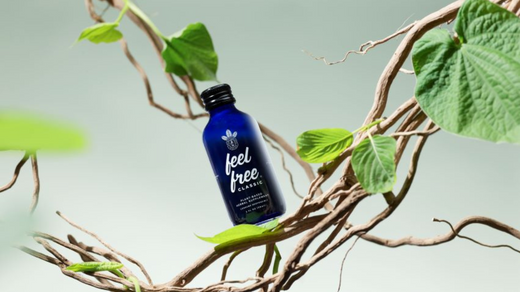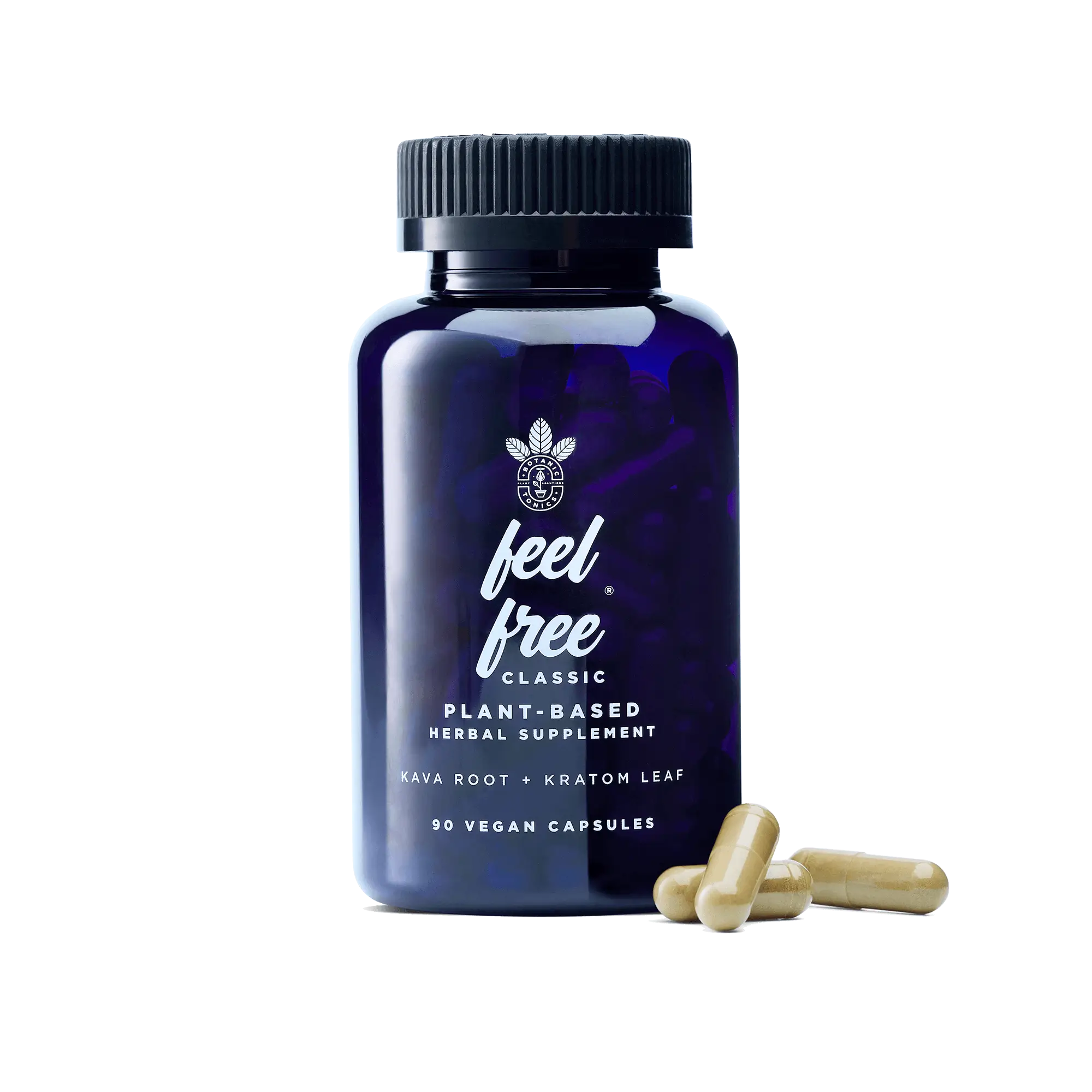While all kava comes from the same plant, a shrub called Piper methysticum, generations of kava traditions have bred a stunning variety of strains from this single species.[1] If you’re new to kava, you might be surprised to learn how deep the kava iceberg goes.
While the exact number of kava strains varies depending on who you ask, there are at least one hundred distinct varieties.[1] But don’t worry about memorizing them all—kava experts have broken these down into a few easy-to-follow categories.
Kick back and read on to learn about five primary strains of kava and what these labels mean to the aspiring kava connoisseur.
5 Kava Strains
As you explore the focus-driving world of kava, you’ll encounter many strains, each one offering a slightly nuanced experience. From balancing Borogu to artistic Eva, let’s look at five popular Vanuatuan kava strains available to enjoy.[2]
#1 Borogu
One of the most popular kava strains, borogu kava is well known for its minimal side effects.[2] It takes effect quickly and is consumed daily by some people in the Pacific Island of Vanuatu.[2] One researcher even recommended it be used as a default in kava root studies due to its cultural history and balanced results.[7]
Borogu comes in three varieties:[2]
- The standard form, simply called “borogu”
- Borogu temit or “white borogu,” which is considered a premium variety
- Borogu tememe or “red borogu,” which contains much heavier effects and is rarely seen outside the country of Vanuatu
#2 Borongoru
Not to be confused with borogu, borongoru kava is a heavy kava.[2] For this reason, it’s present in many Vanuatu kavas designed for sleep.
Heavy kavas typically receive their effects from the kavalactone dihydromethysticin (DHM), which can cause nausea for some people. But borongoru, on the other hand, contains minimal DHM and instead receives much of its properties from the kavalactone called kavain.[2] Kavain is sometimes associated with reduced anxiety, making this strain a popular choice for those seeking a kava variety for sleep and relaxation.[3]
#3 Eva Kava
This strain belongs to the H category and contains the kavalactones kavain and dihydrokavain (DHK). Like most H-group kavas, eva is often used to promote creativity.[2]
Kava’s effect on creativity is widely discussed among enthusiasts, but some studies seem to support those experiences, too. One study found that ingesting kava not only improved the subjects’ moods but also improved their visual attention and short-term memory retrieval during tasks.[4]
So the next time you reach for a cup of coffee before diving into your latest creative project, you might want to try eva instead. You may be able to find it at a kava bar close to you. If you’re wondering, what is a kava bar? it may just be your new favorite alternative to a traditional bar or coffee shop. Before visiting one, make sure to read up on the kava bar age limit.
#4 Melo Melo
As the name may imply, this kava tends to have a lighter effect than most.[2] Kava enthusiasts sometimes consider it a “party” kava because of the positive mood boost and limited after effects.[2,5]
Another H-group kava legend has it that in ancient cultures, melo melo was reserved exclusively for the chief and high council to enjoy—which speaks volumes for its benefits.[2]
#5 Kava Blends
While specific strains are the purists of the Vanuatuan bunch, they’re not the only kind available. Many kava sellers offer blends from particular regions.[2] The pros curate these to give you the most positive kava experience without having to experiment with individual strains. Different products and brands can formulate their blends for different effects.
Because so many kava varieties come from Vanuatu, a blend from this region can be formulated with precision. Vanuatu also has robust trade rules about kava, specifically banning the export of the nauseating tudei kavas that have previously been mixed in with the slower-growing noble cultivars.[1,5]
This regulation, combined with the diversity of strains and sophisticated growing industry, makes Vanuatu one of the best sources of kava blends.[5]
How Are Kava Strains Created?

Unlike most plants, kava doesn’t produce seeds.[6] The only way to obtain more kava plants is by planting kava root cuttings to clone the parent plant.[2] If you’ve ever propagated a succulent by planting the branch of another’s, it’s a similar concept.
Customized plant strains are typically created by crossbreeding two plants with desirable qualities—but it’s not quite that simple with kava.
Farmers have to try new crops themselves to decide whether the strain is worth propagating.[2] By removing unsavory plants from the batch, they can control the quality of their yields and only clone the crops that produce the desired effects, creating new strains over time.[2]
If this sounds like a tedious process, you’d be right. Thousands of years of careful and precise work have gone into domesticating kava.[1,2] The strains we enjoy now have their roots (literally) in years of ancient Polynesian trial and error.
Why Do Kava Strains Matter?
All the centuries of work farming kava have created strains with various effects.[1,2] Some strains produce milder effects, some may induce nausea, some effects last days, and others only hours.[2]
Knowing your exact strain isn’t always vital if you’re buying a formulated blend from a seller you trust. But if you decide to explore this remarkable plant for yourself, it will serve you well to have some kava strain knowledge in your back pocket to help you achieve your desired experience.
Lastly, kava culture is steeped in tradition. Understanding the various strains can give you better insight into the people whose culture and dedication brought you the kava we have today, helping you form a closer bond with history and your own relationship with this astounding plant. From noble kava ceremonies to meticulous farming practices, this root has a rich and storied past that informs how we should honor and consume it today.
How Kava Strains Are Organized
Kava strains can be organized in several different ways, but these four categories are the ones you’re most likely to encounter: [2,7]
- Country of origin
- Morphology (appearance)
- Chemocode
- Effect Profile
Let’s review each of these categories to see what makes them useful.
By Origin
Many believe kava’s birthplace to be Vanuatu, a nation in the Pacific Ocean made up of about 80 different islands.[4,2] Kava is thought to have been spread throughout South Pacific Islands by ancient seafarers, and today the crop is a major source of income for many Pacific Islander nations.[8]
The kava you see on the market was probably grown in one of the following places:[4]
- Vanuatu
- Fiji
- Papua New Guinea
- Samoa
- Tonga
- Pohnpei
- Hawaiߵi
Each region has its own culture and practices surrounding kava, and some nations even forbid the export of certain varieties. For example, Fijian kava can taste and perform very differently from Hawaiian kava. We’ll mostly focus on strains from Vanuatu, which has the widest diversity in strains and the largest share of export.[1,2,5]
By Morphology
Kava farmers frequently categorize kava strains by appearance, though you likely won’t see these qualities when you buy a kava tonic or a kava powder product. This category is mostly for those who grow the kava plants themselves.[2,6]
Morphology categorization of the kava plant usually involves the plant’s color, size, and shape, as well as leaf characteristics like edges and hairs.[10]
By Chemocode
Let's dive into some specifics of kava science. There are six major kavalactones, the active compounds in kava, and the ratio of the compounds determine the kava chemotype.[1,2] The compounds are numbered 1 through 6. Each kava strain receives a 6-digit number to indicate which kavalactones are most abundant.[1,2] For example, a strain with the chemocode 214653 would contain the number two kavalactone, DHK, followed by the number one kavalactone, called desmethoxyyangonin, and so on.
These numbers are split into further alphabetical groups labeled A through I.[2] The first four groups, A through D, consist of tudei cultivars.[2] These are strains you most likely won’t want to consume.[1,2,3] The effects last about two days (hence the name), and often produce unwanted effects like nausea.[1,2] These tend to be the strongest kavas.[1,2,5]
The other groups contain what are called noble cultivars.[2,3] Groups E and F are more psychoactive, so when it comes to kava, most stick to groups G, H, and I.[2] These groups typically have some combination of 4, 6, or 2 in their first three digits and are generally considered the most desirable kava types for recreational or medicinal use.[2]
By Cultivar
When it comes to kava categories, they are often separated into distinct varieties called cultivars. There are two primary ones we’ll discuss: tudei and noble kava—two different worlds when it comes to your kava experience!
Think of tudei kava like that overly strong coffee that leaves you feeling jittery and not-so-great afterward. It's got some serious punch, but it often comes with unwanted side effects like headaches and nausea. The effects of this type can also last for up to two days [1]. Not exactly the vibe we're going for.
Now, noble kava is where the magic happens. It's like sipping on your favorite herbal tea—smooth, relaxing, and without any of those unpleasant aftereffects [1]. This type of kava is carefully crafted for a delightful experience without the worry of feeling off later.
In short, when it comes to kava, stick with the noble variety for a chill time without the drama!
By Effect Profile
The feelings created by different types of kava are broken down into three categories called effect profiles. The effect profiles are:[3]
- Heady – The heady kava category primarily tends to affect mood, with less of an effect on the body. They’re used for creativity, cheerfulness, and a social boost.
- Heavy – This is the category of kavas that affect the body, causing sedative or “heavy” feelings. These are often found in kavas used for sleep.
- Balanced – Balanced kava strains contain a balanced combo of heady and heavy effects.
Sellers and reviewers frequently use these words to describe what effects a particular strain or blend causes, so you can know the best time to try a kava product.
feel free with Kava from Botanic Tonics

Now you can discover for yourself why island farmers have dedicated themselves to the craft of kava for centuries. Our feel free CLASSIC tonic contains a blend of Vanuatu kava extract and leaf kratom, specially formulated to relieve stress, brighten mood, and give you a clean and jitter-free energy boost.
Our traditional kava comes from the South Pacific and Southeast Asia in a pure, effective form.
Choose your preferred kava taste, strain, and way to feel free, from having a kava tonic or an on-the-go treat with our feel free capsules. No animal products, nuts, gluten, or GMOs. Just the good stuff.
Sources:
Agroforestry Net. Farm and Forestry Production and Marketing Profile for Kava. http://www.agroforestry.net/images/pdfs/Kava_specialty_crop.pdf
American Botanical Council. The Rising and Falling Fortunes of Vanuatu Kava. https://www.herbalgram.org/resources/herbalgram/issues/128/table-of-contents/hg128-feat-kava/
British Journal of Clinical Pharmacology. Kava, the anxiolytic herb: back to basics to prevent liver injury? https://www.ncbi.nlm.nih.gov/pmc/articles/PMC3045554/
Human Psychopharmacology. Enhanced cognitive performance and cheerful mood by standardized extracts of Piper methysticum (Kava-kava). https://onlinelibrary.wiley.com/doi/10.1002/hup.581
Kava Guides. List of Kava Cultivars (75 Single Origin Kava Strains Explained). https://kavaguides.com/strains/
Kava Guides. What Is Kava Kava? Health Benefits, Uses & Side Effects. https://kavaguides.com/what-is-kava/
Kava Guru. How Many Kava Varieties? https://kava.guru/ask-kava-guru/how-many-kava-varieties/
Nutrients. Kava as a Clinical Nutrient: Promises and Challenges. https://www.ncbi.nlm.nih.gov/pmc/articles/PMC7600512/
Scientific Reports. Identification of a Kavain Analog with Efficient Anti-inflammatory Effects. https://www.nature.com/articles/s41598-019-49383-8#Sec1
University of Hawaiߵi at Mānoa. Traditional Pacific Island Crops: Kava. https://guides.library.manoa.hawaii.edu/paccrops/kava
















